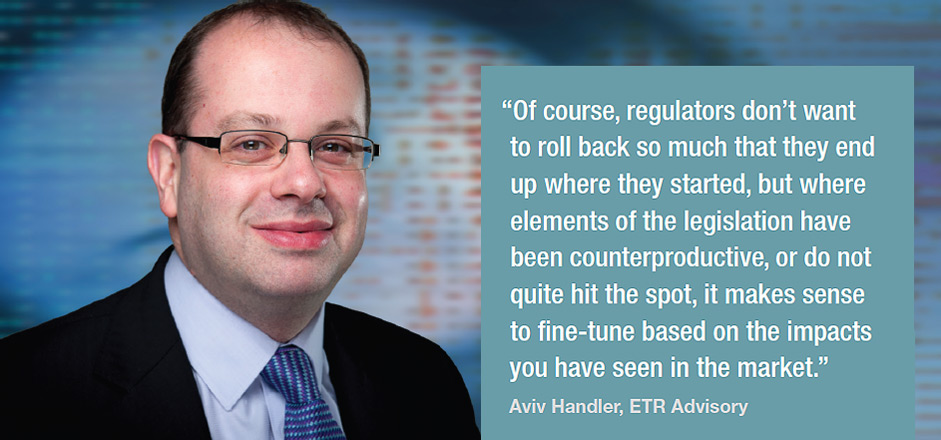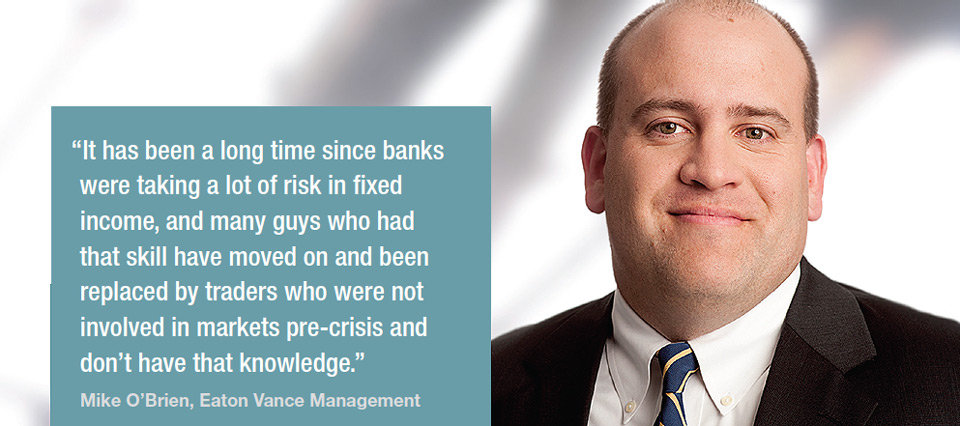Cautious optimism on Dodd Frank roll-back.
The US regulatory response to the financial crisis has shifted trading risk from sell-side to buy-side desks, making reform welcome. David Wigan reports.
Eight years after it was implemented in the wake of the financial crisis, the Dodd Frank Wall Street Reform and Consumer Protection Act is beginning to crumble. Recent activity in Congress suggests that moves to suppress parts of the Act are in full swing and will continue in the months ahead. For the bond markets, the implications are uncertain, with hopes for better liquidity offset by the suspicion that technology rather than regulatory tweaking is the way forward. Nevertheless, the Volcker Rule, which severely limits proprietary trading of assets including corporate bonds, is one part of Dodd Frank seen to negatively impact bond liquidity.

“When you talk about making changes to Volcker I think it could be helpful from a market perspective,” says Alex Sedgwick, head of fixed income market structure and electronic trading at T. Rowe Price in Baltimore. “It can be fairly difficult in certain asset classes to differentiate between market marking and prop trading if it is based on anticipating short-term liquidity demands in illiquid assets. So, to the extent that reforms clarify that requirement, they may be supportive of greater liquidity.”
On 24 May 2018, President Trump signed into law the Economic Growth, Regulatory Relief, and Consumer Protection Act (S.2155; Pub. L. No. 115-174), creating a milestone in the revision of Dodd Frank, which has been on the Republican agenda since the Act was implemented under President Obama in 2010. In signing the legislation Trump said it was “a great day for America” which went some way to fulfilling his 2016 promise to “dismantle” Dodd Frank legislation that “does not work for working people”.
Section 2155 was a relatively minor but significant step in that direction. It creates simplified capital rules, making banks with assets of less than $10 billion effectively exempt from risk-based capital requirements, including Basel III. Systemically important financial institutions (banks with assets of $50-$100 billion) are exempt under the legislation from Dodd Frank enhanced prudential standards. Institutions with assets of $100 billion to $250 billion are exempt from enhanced prudential standards other than stress testing (after 18 months). However, the Federal Reserve will have discretion to apply prudential standards to these banks.
Other measures include softer eligibility requirements for the liquidity coverage ratio, reduced data reporting obligations, more freedom for mutual banks to offer a wider range of products, and an exemption for banks with assets of less than $10 billion from the Volcker Rule, which restricts proprietary trading and investment in hedge and private equity funds.
From a market participant perspective, large parts of S.2155 seem to make a lot of sense, dialling back some elements of the original legislation, which in the immediate aftermath of the financial crisis appeared appropriate but quickly became tired.

“Parts of the post-crisis regulation have been deemed by some to have had unintended consequences,” says Aviv Handler, a UK-based regulatory consultant. “Of course, regulators don’t want to roll back so much that they end up where they started, but where elements of the legislation have been counterproductive, or do not quite hit the spot, it makes sense to fine-tune based on the impacts you have seen in the market.”
Due process
If moderation is the wisest strategy, then a salient question is how far policy makers wish to go on hobbling Dodd Frank? Certainly, S.2155 is part of a much bigger picture and just one of several ongoing reform efforts. These include various provisions advancing through the House Financial Services Committee, provisions included in the House’s appropriations bill, and recommendations still to come from the fourth and final Treasury Report pursuant to President Trump’s Executive Order 13772 (titled Core Principles for Regulating the United States Financial System), signed in February 2017.
Much of President Trump’s ambition for US regulatory reform was encapsulated in the Financial CHOICE Act, which passed through the House of Representatives in June last year. The Act is the daddy of S.1255, containing some similar provisions and many more which did not eventually win enough bipartisan support to make it into law. One key difference is that S.1255 authorises federal regulators to disqualify banks from regulatory relief if they are deemed too risky, based on factors including off-balance-sheet exposures, trading assets and liabilities, and derivative exposures. The CHOICE Act makes no such allowances, instead providing relief to all banks that maintain a sufficient capital ratio. CHOICE exempts banks from numerous capital and liquidity regulations and all of “heightened prudential standards” implemented by section 165 of Dodd Frank. The bill passed last year in the House of Representatives but died in the Senate, where there was insufficient bipartisan support. Still, elements are now making their way through the legislative process.
S.2155, meanwhile, is in the midst of a 180-day regulatory guidance period, in which agencies draft the accompanying regulations that will enforce the statute. In the meantime, the industry has been asked to comment on the equally important Volcker rule, also known as section 13 to the Bank Holding Company Act of 1956 (“BHC Act”), created by Section 619 of the Dodd Frank Act.
A Federal Register Notice published on 30 May invited comment on proposed revisions to section 13, which it said “are intended to provide banking entities with clarity about what activities are prohibited and to improve supervision and implementation of section.” In practice the 373-page proposal’s most significant change focuses on two areas. First, it reduces the impact of the rule on smaller banks and second it amends the definitions relating to the prop trading prohibition, and in particular the definition of a “trading account”, to which the rule applies. A key element of that definition is that it includes any account used for the purpose of holding “short-term” positions, assumed to be where the bank holds the security for fewer than 60 days. The proposal is to remove that definition of a trading account completely, effectively blowing a huge hole in the current restriction.
Cautious welcome
The implication for trading desks is fairly clear. A reduced constraint on holding securities for a short period invites banks to apply more balance sheet for the purposes of trading and should theoretically lead to an increase in market liquidity.
Still, said Sedgwick, some dealers have changed the way they provide liquidity over time, doing more trades on an agency basis. For more liquid securities, many are making markets algorithmically, which is more efficient and supports electronic trading.
“Some banks have adapted to tighter bid-offer spreads by using technology to trade with greater velocity,” he says. “This is a secular change in the way the market works and having evolved since the crisis is likely to persist.”
One caveat to that view is that the move to electronic market making has come at a time of low volatility, which is a constructive backdrop for computer-generated pricing. Higher US interest rates may fuel bond market volatility, which may lead to an increased role for human input into pricing, higher bid-offer spreads and therefore more capital being committed to the business.
Still, there are also compelling dynamics that militate against a return to former ways. Among those is bank operating models, and the fact that the set up in the front office has changed.

“Even if you roll back Dodd Frank and Volcker you won’t necessarily see banks quickly return to traditional market making because the skillset has gone on the sell side,” says Mike O’Brien, vice president and director of global trading at Boston-based Eaton Vance Management. “It has been a long time since banks were taking a lot of risk in fixed income, and many guys who had that skill have moved on and been replaced by traders who were not involved in markets pre-crisis and don’t have that knowledge.”
Certainly, the changes instituted by Dodd Frank and Volcker have had an impact on the way the buy side does business, said O’Brien, in effect transferring execution risk from the buy side to the sell side.
“Under the agency model, the buy-side firm has to hold the risk while the bank tries to find someone to take the other side of the trade,” he says. “You now need to be much more careful about how you trade, and you need to trade in much smaller sizes. That first call that you make as a trader is much more important because you want to understand who might have an axe in your favour, and you don’t want to leak information without getting something in return.”
In response to lower levels of dealer liquidity, the bond markets have in recent years seen the emergence of a range of new trading protocols, an evolution in trading platforms, and the vast majority of smaller trades are now executed electronically.
“We have seen some significant advances in terms of discovering ways to find matching interest in the markets,” said T. Rowe Price’s Sedgwick. “On the other hand, fixed income fundamentally runs up against the issue of there not being enough buyers and sellers of a particular security in the market at the same time, and dealers always have, and still do, play a crucial role in addressing that. With that in mind, the moves to make it easier for banks to make markets are positive.”
©Markets Media Europe 2025

























